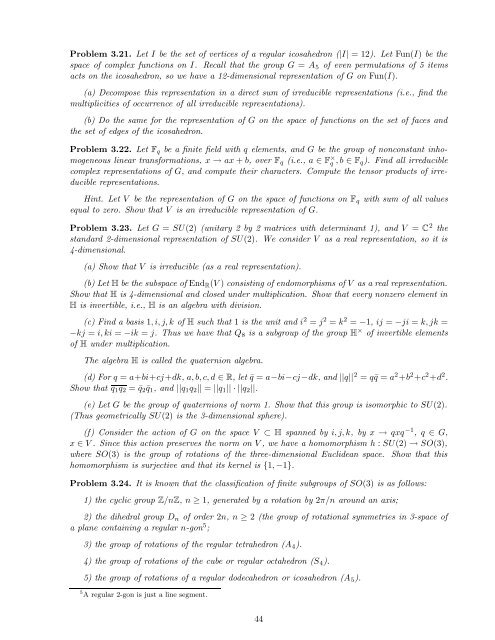Lecture notes for Introduction to Representation Theory
Lecture notes for Introduction to Representation Theory
Lecture notes for Introduction to Representation Theory
You also want an ePaper? Increase the reach of your titles
YUMPU automatically turns print PDFs into web optimized ePapers that Google loves.
Problem 3.21. Let I be the set of vertices of a regular icosahedron ( | I | = 12). Let Fun(I) be the<br />
space of complex functions on I. Recall that the group G = A 5 of even permutations of 5 items<br />
acts on the icosahedron, so we have a 12-dimensional representation of G on Fun(I).<br />
(a) Decompose this representation in a direct sum of irreducible representations (i.e., find the<br />
multiplicities of occurrence of all irreducible representations).<br />
(b) Do the same <strong>for</strong> the representation of G on the space of functions on the set of faces and<br />
the set of edges of the icosahedron.<br />
Problem 3.22. Let F q be a finite field with q elements, and G be the group of nonconstant inhomogeneous<br />
linear trans<strong>for</strong>mations, x ⊃ ax + b, over F q (i.e., a F × q , b F q ). Find all irreducible<br />
complex representations of G, and compute their characters. Compute the tensor products of irreducible<br />
representations.<br />
Hint. Let V be the representation of G on the space of functions on F q with sum of all values<br />
equal <strong>to</strong> zero. Show that V is an irreducible representation of G.<br />
Problem 3.23. Let G = SU(2) (unitary 2 by 2 matrices with determinant 1), and V = C 2 the<br />
standard 2-dimensional representation of SU(2). We consider V as a real representation, so it is<br />
4-dimensional.<br />
(a) Show that V is irreducible (as a real representation).<br />
(b) Let H be the subspace of End R (V ) consisting of endomorphisms of V as a real representation.<br />
Show that H is 4-dimensional and closed under multiplication. Show that every nonzero element in<br />
H is invertible, i.e., H is an algebra with division.<br />
(c) Find a basis 1, i, j, k of H such that 1 is the unit and i 2 = j 2 = k 2 = −1, ij = −ji = k, jk =<br />
−kj = i, ki = −ik = j. Thus we have that Q 8 is a subgroup of the group H × of invertible elements<br />
of H under multiplication.<br />
The algebra H is called the quaternion algebra.<br />
(d) For q = a+bi+cj+dk, a, b, c, d R, let q¯ = a−bi−cj−dk, and ||q|| 2 = qq¯ = a 2 +b 2 +c 2 +d 2 .<br />
Show that q 1 q 2 = q¯2q¯1, and ||q 1 q 2 || = ||q 1 || · ||q 2 ||.<br />
(e) Let G be the group of quaternions of norm 1. Show that this group is isomorphic <strong>to</strong> SU(2).<br />
(Thus geometrically SU(2) is the 3-dimensional sphere).<br />
(f) Consider the action of G on the space V → H spanned by i, j, k, by x ⊃ qxq −1 , q G,<br />
x V . Since this action preserves the norm on V , we have a homomorphism h : SU(2) ⊃ SO(3),<br />
where SO(3) is the group of rotations of the three-dimensional Euclidean space. Show that this<br />
homomorphism is surjective and that its kernel is {1, −1}.<br />
Problem 3.24. It is known that the classification of finite subgroups of SO(3) is as follows:<br />
1) the cyclic group Z/nZ, n ⊂ 1, generated by a rotation by 2β/n around an axis;<br />
2) the dihedral group D n of order 2n, n ⊂ 2 (the group of rotational symmetries in 3-space of<br />
a plane containing a regular n-gon 5 ;<br />
3) the group of rotations of the regular tetrahedron (A 4 ).<br />
4) the group of rotations of the cube or regular octahedron (S 4 ).<br />
5) the group of rotations of a regular dodecahedron or icosahedron (A 5 ).<br />
5 A regular 2-gon is just a line segment.<br />
44

















